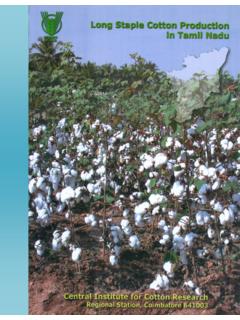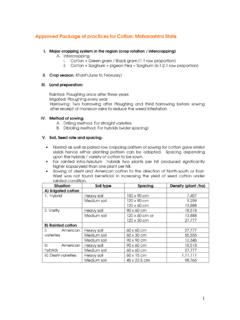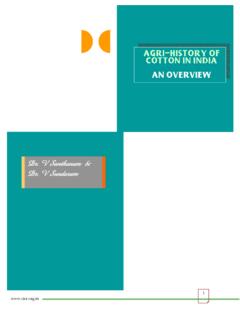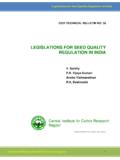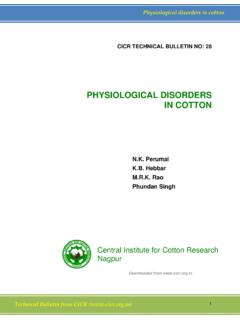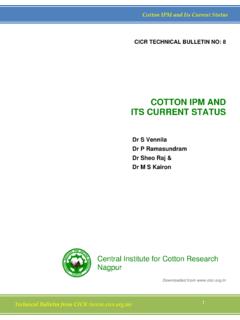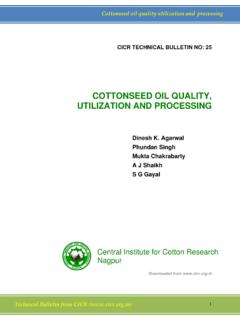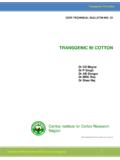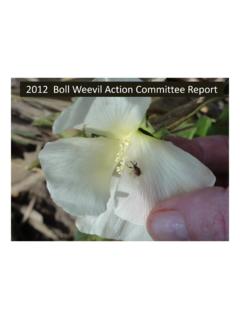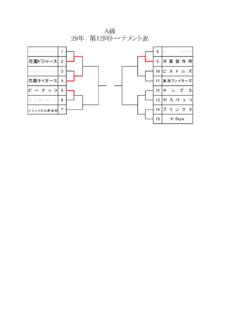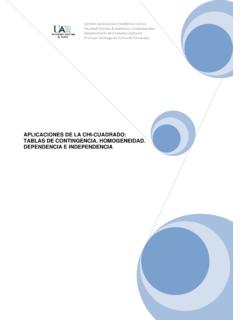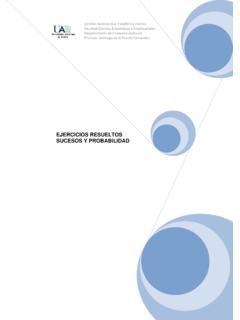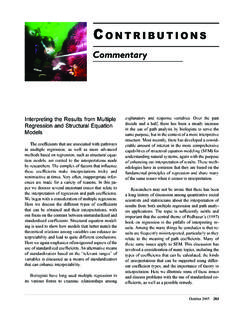Transcription of Pink Bollworm Strikes Bt-Cotton
1 2015-16 No. 35 1st December, 2015 Published every TuesdayCottonAssociationof IndiaEdited & Published by Amar SinghWeekly Publication ofCotton Exchange Building, 2nd Floor, Cotton Green, Mumbai - 400 033 Phone: 30063400 Fax: 2370 0337 Email: (Dr. Kranthi, Director of Central Institute for Cotton Research (CICR), Nagpur has completed his in Entomology from IARI, New Delhi. He has more than 20 years of experience in the field of cotton research.)The pink Bollworm is back with a vengeance. This insect was a serious concern for cotton in India about 30 years ago.
2 There were very few reports of any major damage by pink Bollworm to cotton since 1982 in the country. But all that has changed now. This year, severe damage to bolls by pink Bollworm and yield-losses were observed in Bt-Cotton in many regions of Gujarat and some parts of AP, Telangana and Maharashtra. More concerning is the fact that the worm is happily chewing up Bollgard-II- Bt-Cotton which contains two genes (cry1Ac+cry2Ab) that were supposed to be highly effective in controlling the pest.
3 Studies conducted by ICAR-CICR (Central Institute for Cotton Research, Nagpur) over the past two years, clearly showed that the pink Bollworm developed resistance to two Cry toxins deployed in Bollgard-II. It is important to unravel the mystery as to why the worm has returned after 30 years to trouble cotton again. And that too, with a vengeance to break a technology called Bollgard-II that was supposed to be all was in Gujarat last week with a team of three senior colleagues of ICAR-CICR.
4 Dr. Sandhya Kranthi, Head Crop Improvement; Dr. A. H. Prakash, Project Co-ordinator and Head of our regional station in Coimbatore and Dr. Venugopalan, Head of the PME unit, were part of the team. We toured across Ahmedabad, Surendranagar, Rajkot, Junagarh, Amreli and Bhavnagar. Our visit was a follow-up to the concern expressed by an earlierteam of experts after their visit to Gujarat. My colleague Dr. Chinna Babu Naik and his team had visited Gujarat in the first week of November to assess pink boll worm infestation on Bollgard-II.
5 Dr. Naik was categorical when he declared that this season the pink Bollworm has spread across Gujarat mostly in green bolls for second picking that are affected seriously in Junagarh, Amreli, Bhavnagar and Bharuch . A woman farmer in Bhavnagar plucked a few green bolls randomly from a plant and pulled out a sickle to open them. She said something angrily in Gujarati, not a single word that I knew, but clearly understood what she conveyed. The interpreter confirmed that she said Look, every green boll has this red coloured insect inside, fully grown and feeding on developing seeds.
6 Another farmer remarked Bollgard-II is no longer effective on pink Bollworm . We are using insecticides to control it . The farmer echoed the feeling of many farmers in Gujarat who are just beginning to experience the failure of Bollgard-II to control the pink Bollworm . The damage was more especially in the green bolls forsecond and subsequent pickings. Our approximate estimates indicate that Gujarat may have lost 7-8% of its cotton to the pink Bollworm this year.
7 More concerning is the fact that the farmer would get a lower price for the second and third picked cotton because of the poor quality. At a time when the market prices are low, this could compound the stress. I remember my visit to Gujarat in November last year. It was clear that not many farmers were aware of the damage that the pink Bollworm was causing to green bolls of Bollgard-II. This year, there was a huge difference. Farmers were not only aware of the impending problem of pink Bollworm , but pink Bollworm Strikes Bt-CottonCotton StatiStiCS & newS 2 1st December, 2015many also knew precisely how to manage it.
8 Our personal interaction with farmers across Saurashtra this year in mid November, clearly mirrored the enormous efforts that were made by the Government departments and private agencies. These efforts clearly showcase a success story of how combined efforts from a central research institute ICAR-CICR, the Junagarh Agricultural University (JAU), the State Agricultural Department, the Central Ministry, the seed industry, (Krishi Vigyan Kendra) KVKs and NGOs to educate farmers on pest management could help farmers to efficiently manage insect pests to minimise yield losses.
9 It was heartening to note that the weekly advisories issued by CICR on the institute s web site formed the core essence of the management strategies all across the state. It was also clear that wherever the recommendations were followed, the fields had very less infestation at negligible levels in the first picked cotton and as less as 5-10% in the green bolls for second picking. Interestingly, about 60-70% of the farmers whom we met had followed the conducted by ICAR-CICR showed that pink bollworms were also surviving on Bollgard-II not only in Gujarat but also in parts of AP, Telangana and Maharashtra.
10 Though the following passages describe the situation with focus in Gujarat, the problem seems to be engulfing regions in other states especially where cotton crop is being extended beyond 180 days, sometimes extending it all through the BollwormPink Bollworm , Pectinophora gossypiella (Saunders) is presumed to have an Indo-Pak origin. The larvae feed only on a few crops such as cotton, bhendi (okra), Hibiscus, and are laid on flowers, young bolls, axils of petioles and underside of young leaves.

